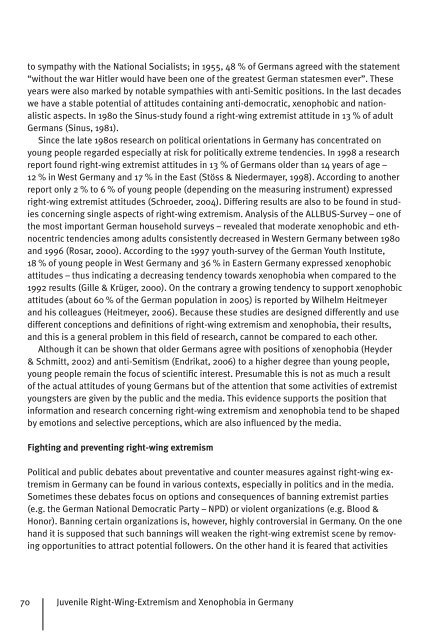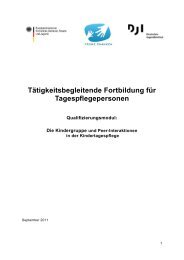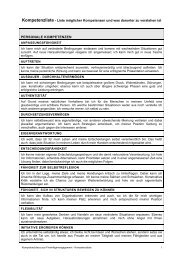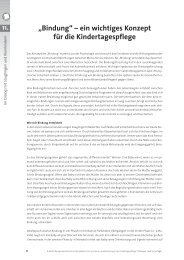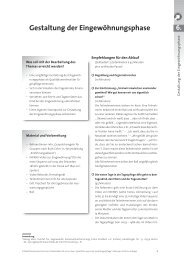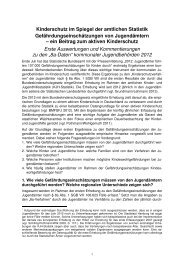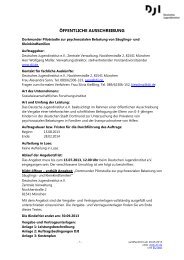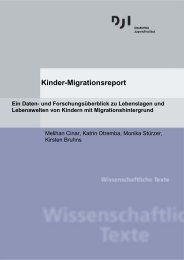Prevention of Right-Wing Extremism, Xenophobia and Racism in ...
Prevention of Right-Wing Extremism, Xenophobia and Racism in ...
Prevention of Right-Wing Extremism, Xenophobia and Racism in ...
You also want an ePaper? Increase the reach of your titles
YUMPU automatically turns print PDFs into web optimized ePapers that Google loves.
to sympathy with the National Socialists; <strong>in</strong> 1955, 48 % <strong>of</strong> Germans agreed with the statement<br />
“without the war Hitler would have been one <strong>of</strong> the greatest German statesmen ever”. These<br />
years were also marked by notable sympathies with anti-Semitic positions. In the last decades<br />
we have a stable potential <strong>of</strong> attitudes conta<strong>in</strong><strong>in</strong>g anti-democratic, xenophobic <strong>and</strong> nation-<br />
alistic aspects. In 1980 the S<strong>in</strong>us-study found a right-w<strong>in</strong>g extremist attitude <strong>in</strong> 13 % <strong>of</strong> adult<br />
Germans (S<strong>in</strong>us, 1981).<br />
S<strong>in</strong>ce the late 1980s research on political orientations <strong>in</strong> Germany has concentrated on<br />
young people regarded especially at risk for politically extreme tendencies. In 1998 a research<br />
report found right-w<strong>in</strong>g extremist attitudes <strong>in</strong> 13 % <strong>of</strong> Germans older than 14 years <strong>of</strong> age –<br />
12 % <strong>in</strong> West Germany <strong>and</strong> 17 % <strong>in</strong> the East (Stöss & Niedermayer, 1998). Accord<strong>in</strong>g to another<br />
report only 2 % to 6 6 % <strong>of</strong> young young people (depend<strong>in</strong>g on the measur<strong>in</strong>g <strong>in</strong>strument) <strong>in</strong>strument) expressed<br />
right-w<strong>in</strong>g extremist attitudes (Schroeder, 2004). Differ<strong>in</strong>g results are also to be found <strong>in</strong> stud-<br />
ies concern<strong>in</strong>g s<strong>in</strong>gle aspects <strong>of</strong> right-w<strong>in</strong>g extremism. extremism. Analysis <strong>of</strong> the ALLBUS-Survey – one <strong>of</strong><br />
the most important German household surveys – revealed that moderate xeno phobic <strong>and</strong> eth-<br />
nocentric tendencies among adults consistently decreased <strong>in</strong> Western Germany between 1980<br />
<strong>and</strong> 1996 (Rosar, 2000). Accord<strong>in</strong>g to the 1997 youth-survey <strong>of</strong> the German Youth Institute,<br />
18 % <strong>of</strong> young people <strong>in</strong> West Germany <strong>and</strong> 36 % <strong>in</strong> Eastern Germany expressed xenophobic<br />
attitudes – thus <strong>in</strong>dicat<strong>in</strong>g a decreas<strong>in</strong>g tendency towards xenophobia when compared to the<br />
1992 results (Gille & Krüger, 2000). On the contrary a grow<strong>in</strong>g tendency to support xenophobic<br />
attitudes (about 60 % <strong>of</strong> the German population <strong>in</strong> 2005) is reported by Wilhelm Heitmeyer<br />
<strong>and</strong> his colleagues (Heitmeyer, 2006). Because these studies are designed differently <strong>and</strong> use<br />
different conceptions <strong>and</strong> defi nitions <strong>of</strong> right-w<strong>in</strong>g extremism <strong>and</strong> xenophobia, their results,<br />
<strong>and</strong> this is a general problem <strong>in</strong> this fi eld <strong>of</strong> research, cannot be compared to each other.<br />
Although it can be shown that older Germans agree with positions <strong>of</strong> xenophobia (Heyder<br />
& Schmitt, 2002) <strong>and</strong> anti-Semitism (Endrikat, 2006) to a higher degree than young people,<br />
young people rema<strong>in</strong> the focus <strong>of</strong> scientifi c <strong>in</strong>terest. Presumable this is not as much a result<br />
<strong>of</strong> the actual attitudes <strong>of</strong> young Germans but <strong>of</strong> the attention that some activities <strong>of</strong> extremist<br />
youngsters are given by the public <strong>and</strong> the media. This evidence supports the position that<br />
<strong>in</strong>formation <strong>and</strong> research concern<strong>in</strong>g right-w<strong>in</strong>g extremism <strong>and</strong> xenophobia tend to be shaped<br />
by emotions <strong>and</strong> selective perceptions, which are also <strong>in</strong>fl uenced by the media.<br />
Fight<strong>in</strong>g <strong>and</strong> prevent<strong>in</strong>g right-w<strong>in</strong>g extremism<br />
Political <strong>and</strong> public debates about about preventative <strong>and</strong> counter measures aga<strong>in</strong>st right-w<strong>in</strong>g exex- tremism <strong>in</strong> Germany can be found <strong>in</strong> various contexts, especially <strong>in</strong> politics <strong>and</strong> <strong>in</strong> the media.<br />
Sometimes these debates focus on options <strong>and</strong> consequences <strong>of</strong> bann<strong>in</strong>g extremist parties<br />
(e.g. the German National Democratic Party – NPD) or violent organizations (e.g. Blood &<br />
Honor). Bann<strong>in</strong>g certa<strong>in</strong> organizations is, however, highly controversial <strong>in</strong> Germany. On the one<br />
h<strong>and</strong> it is supposed supposed that such bann<strong>in</strong>gs will weaken the right-w<strong>in</strong>g extremist scene by remov-<br />
<strong>in</strong>g opportunities opportunities to attract potential followers. On the other h<strong>and</strong> it is feared that activities<br />
70 Juvenile <strong>Right</strong>-<strong>W<strong>in</strong>g</strong>-<strong>Extremism</strong> <strong>and</strong> <strong>Xenophobia</strong> <strong>in</strong> Germany


